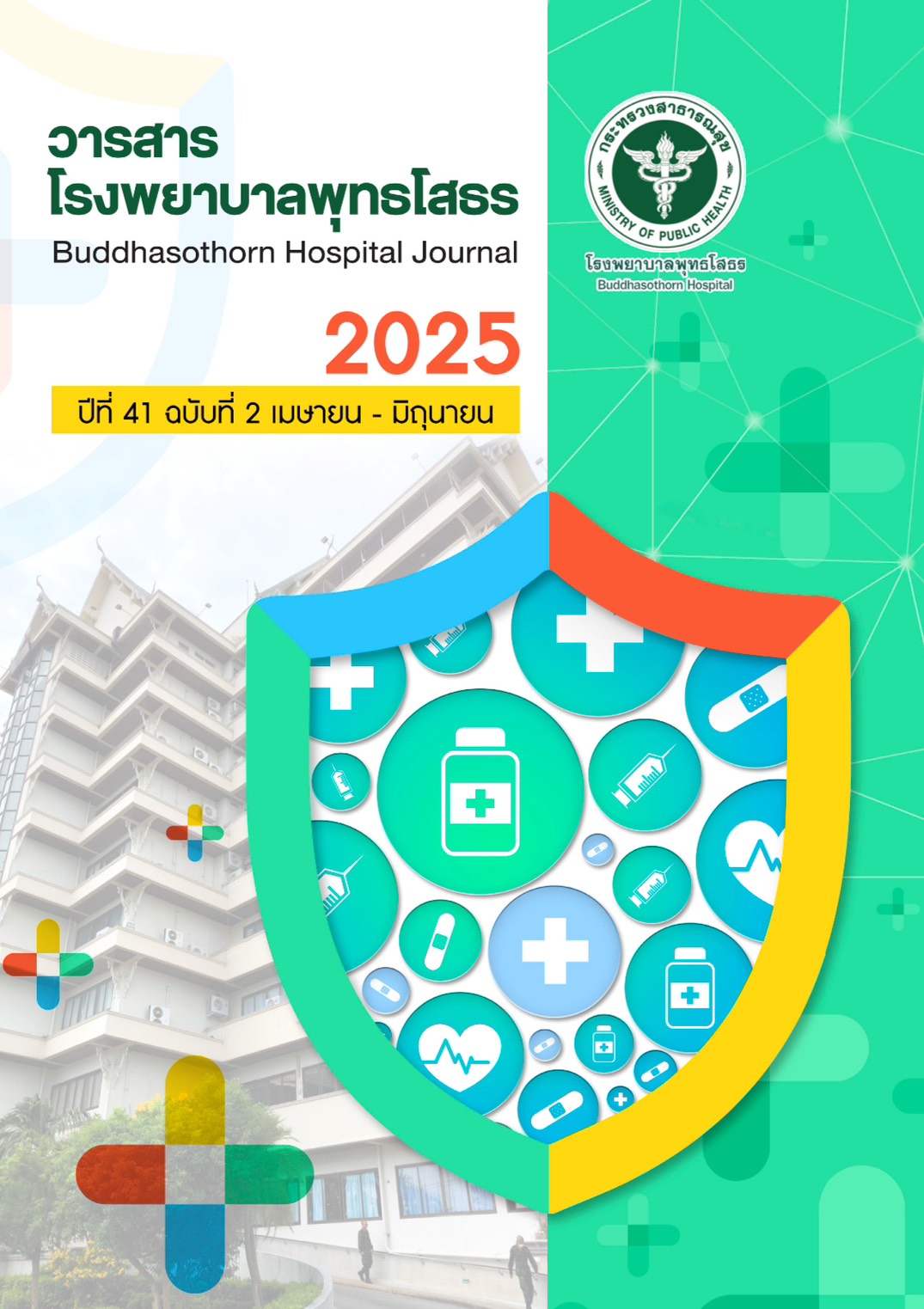ความแม่นยำของระดับค่าเอนไซม์ตับเป็นตัวทำนายการคัดกรองการบาดเจ็บของตับในผู้ป่วยอุบัติเหตุกระทบกระเทือนช่องท้อง
Main Article Content
บทคัดย่อ
บทนำ:การเพิ่มขึ้นของ AST และ ALT มีความสัมพันธ์กับการบาดเจ็บของตับจากอุบัติเหตุกระทบกระเทือนช่องท้อง สามารถนำมาช่วยวินิจฉัยและบอกระดับความรุนแรงได้ ทำให้เกิดการรักษาที่มีประสิทธิภาพและเพิ่มความรวดเร็วในการวินิจฉัย
วัตถุประสงค์:เพื่อศึกษาความแม่นยำของระดับค่าเอนไซม์ตับ ในการคัดกรองการบาดเจ็บของตับในผู้ป่วยอุบัติเหตุกระทบกระเทือนช่องท้อง
วิธีการศึกษา:เป็นการเก็บข้อมูลย้อนหลังในผู้ป่วยอุบัติเหตุกระทบกระเทือนช่องท้องที่เข้ารับบริการในห้องอุบัติเหตุฉุกเฉินและรับไว้เป็นผู้ป่วยในของโรงพยาบาลชลบุรี ระหว่างวันที่ 01 มกราคม 2562 – 31 กรกฎาคม 2564 คำนวณขนาดตัวอย่างทั้งสิ้น 162 คน และวิเคราะห์สถิติโดยศึกษาความแม่นยำค่าเอมไซม์ตับ ใช้ diagnostic test แสดงค่าความไว ความจำเพาะ positive predictive value (PPV), negative predictive value(NPV), positive likelihood ratio, negative likelihood ratio และ area under the receiver operating characteristic curve (AUROC) และหาปัจจัยทำนายการบาดเจ็บของตับด้วย logistic regression
ผลการศึกษา: ผู้ป่วย 162 รายมีการบาดเจ็บของตับ 78 ราย (ร้อยละ 48.14) เมื่อเปรียบเทียบจุดตัดที่เหมาะสม และ ROC curve เพื่อประเมินการพยากรณ์ของค่าเอนไซม์ตับในผู้ป่วยอุบัติเหตุกระทบกระเทือนช่องท้องพบว่า จุดตัดที่เหมาะสมสำหรับ AST คือ ≥185หน่วยยูนิตต่อลิตร (U/L) มีความไว 84.6% และความจำเพาะ 88.0% (AuROC) 0.92 และจุดตัดที่เหมาะสมสำหรับ ALT คือ ≥127 หน่วยยูนิตต่อลิตร (U/L) มีความไว 84.6% และความจำเพาะ 89.2% (AuROC) 0.93 เมื่อวิเคราะห์แบบ multiple logistic regression พบว่า เพศหญิง อายุ AST≥185 U/L และ ALT ≥127 U/L สามารถร่วมทำนายการบาดเจ็บของตับในผู้ป่วยอุบัติเหตุกระทบกระเทือนช่องท้องได้
สรุปผลการศึกษา: AST≥185 U/L และ ALT ≥127 U/L สามารถใช้เป็นค่าจุดตัดเพื่อช่วยคัดกรองผู้ที่อาจจะมีตับบาดเจ็บในกลุ่มผู้ป่วยอุบัติเหตุกระทบกระเทือนช่องท้อง อย่างไรก็ตามการตัดสินใจส่งตัวผู้ป่วยมา CT scan ไม่ควรอาศัยเฉพาะระดับค่า AST ALT เพียงอย่างเดียว ซึ่งอาจประเมิน เพศ และอายุ รวมถึงสัญญาณชีพร่วมด้วย
Article Details

This work is licensed under a Creative Commons Attribution-NonCommercial-NoDerivatives 4.0 International License.
References
American College of Surgeons, Committee on Trauma. Advanced trauma life support: student course manual. 2018.
Kozar RA, Crandall M, Shanmuganathan K, Zarzaur BL, Coburn M, Cribari C, et al. Organ injury scaling 2018 update: Spleen, liver, and kidney. J Trauma Acute Care Surg. 2018 Dec;85(6):1119–22.
Taghavi S, Askari R. Liver Trauma. In: StatPearls [Internet]. Treasure Island (FL): StatPearls Publishing; 2022 [cited 2022 Oct 22]. Available from: http://www.ncbi.nlm.nih.gov/books/NBK513236/
Brown CK, Dunn KA, Wilson K. Diagnostic evaluation of patients with blunt abdominal trauma: a decision analysis. Acad Emerg Med Off J Soc Acad Emerg Med. 2000 Apr;7(4):385–96.
Alghamdi H. Liver Trauma [Internet]. Recent Advances in Liver Diseases and Surgery. IntechOpen; 2015 [cited 2021 Nov 8]. Available from: https://www.intechopen.com/chapters/49218
Amornvittayachan O. Diagnoses Blunt Abdominal Injuries by Computed Tomography. J Med Health Sci. 2014 Jul 29;21(1):54–62.
Lee WC, Kuo LC, Cheng YC, Chen CW, Lin YK, Lin TY, et al. Combination of white blood cell count with liver enzymes in the diagnosis of blunt liver laceration. Am J Emerg Med. 2010 Nov;28(9):1024–9.
Fleming S, Bird R, Ratnasingham K, Sarker SJ, Walsh M, Patel B. Accuracy of FAST scan in blunt abdominal trauma in a major London trauma centre. Int J Surg. 2012 Jan 1;10(9):470–4.
Ahmed N, Vernick JJ. Management of liver trauma in adults. J Emerg Trauma Shock. 2011 Jan;4(1):114–9.
Tian Z, Liu H, Su X, Fang Z, Dong Z, Yu C, et al. Role of elevated liver transaminase levels in the diagnosis of liver injury after blunt abdominal trauma. Exp Ther Med. 2012 Aug;4(2):255–60.
Koyama T, Hamada H, Nishida M, Naess PA, Gaarder C, Sakamoto T. Defining the optimal cut-off values for liver enzymes in diagnosing blunt liver injury. BMC Res Notes. 2016 Jan 25;9:41.
Prasad P, Acharya A, Vithon GE, Kumar GNM. Evaluating the role of liver enzymes as predictors of severity of liver injury in patients with blunt abdominal trauma. Int J Res Med Sci. 2017 May 27;5(6):2462–7.
Shrestha A, Neupane HC, Tamrakar KK, Bhattarai A, Katwal G. Role of liver enzymes in patients with blunt abdominal trauma to diagnose liver injury. Int J Emerg Med. 2021 Jan 19;14(1):7.
Chang C, Lin H, Liao Y, Chu F, Chen K. Elevated Aminotransferases are Predictors of Hepatic Injury in Blunt Abdominal Trauma Patients. Hong Kong J Emerg Med. 2013 Nov;20(6):337–42.
Ritchie AH, Williscroft DM. Elevated liver enzymes as a predictor of liver injury in stable blunt abdominal trauma patients: case report and systematic review of the literature. Can J Rural Med Off J Soc Rural Physicians Can J Can Med Rurale J Off Soc Med Rurale Can. 2006;11(4):283–7.
Tan KK, Bang SL, Vijayan A, Chiu MT. Hepatic enzymes have a role in the diagnosis of hepatic injury after blunt abdominal trauma. Injury. 2009 Sep;40(9):978–83.
Jusoh A, Ghazi FN. Triple elevation of ALT is indicative of blunt hepatic trauma. Our local experience at rural district hospita. Glob Surg. 2016 Jan 1;26.
Bruhn PJ, Østerballe L, Hillingsø J, Svendsen LB, Helgstrand F. Posttraumatic levels of liver enzymes can reduce the need for CT in children: a retrospective cohort study. Scand J Trauma Resusc Emerg Med. 2016 Aug 25;24(1):104.
Lala V, Zubair M, Minter DA. Liver Function Tests. In: StatPearls [Internet]. Treasure Island (FL): StatPearls Publishing; 2022 [cited 2022 Oct 22]. Available from: http://www.ncbi.nlm.nih.gov/books/NBK482489/
Arslan G, Gemici AA, Yirgin IK, Gulsen E, Inci E. Liver trauma grading and biochemistry tests. Emerg Radiol. 2013 Oct;20(5):379–84.
Kaku N. Short-term and long-term changes in hepatic function in 60 patients with blunt liver injury. J Trauma. 1987 Jun;27(6):607–14.
Cogbill TH, Moore EE, Feliciano DV, Jurkovich GJ, Morris JA, Mucha P. Hepatic enzyme response and hyperpyrexia after severe liver injury. Am Surg. 1992 Jul 1;58(7):395–9.
Srivastava AR, Kumar S, Agarwal GG, Ranjan P. Blunt abdominal injury: serum ALT-A marker of liver injury and a guide to assessment of its severity. Injury. 2007 Sep;38(9):1069–74.
